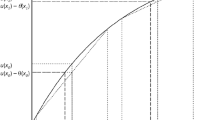Abstract
We propose a reasonable condition, which we call repetitive risk aversion (RRA), to be imposed on any utility function to account for the observed data on the relationship between the degree of absolute risk aversion and wealth. We deduce this condition from the concept of the fear of ruin (Aumann and Kurz 1977) and show it to be equivalent to the behaviorally meaningful condition that the risk premium is increasing at a non-increasing rate with the size of the bet. We drive mixed risk aversion, which is known to be stronger than standard and thus proper risk aversion, from RRA. We present several economic applications of RRA to demonstrate that it delivers better comparative static results.
Similar content being viewed by others
References
Alesina A., Tabellini G. (1990). Voting on budget deficit. Am Econ Rev 80:37–49
Aumann R.J., Kurz M. (1977). Power and taxes. Econometrica 45:1137–60
Burgos A., Grant S., Kajii A. (2002). Bargaining and boldness. Games Econ Behav 38:28–51
Caballé J., Pomansky A. (1996). Mixed risk aversion. J Econ Theory 71:485–513
Chander P., Wilde L. (1998). A general characterization of optimal income tax enforcement. Rev Econ Stud 65:165–183
Dachraoui K., Dionne G., Eeckhoudt L., Godfroid G. (2004). Comparative mixed risk aversion: definition and application to self-protection and willingness to pay. J Risk Uncertain 29:261–276
Debreu G., Koopmans T. (1982). Additively decomposed quasi-convex functions. Math Program 24:1–38
Dionne G., Fombaron N. (1996). Non-convexities and efficiency of equilibria in insurance markets with asymmetric information. Econ Lett 52:31–40
Drèze J.H., Modigliani F. (1972). Consumption decisions under uncertainty. J Econ Theory 5:308–335
Eeckhoudt L., Gollier C. (1999). Are independent risks substitutes?. University of Toulouse, Mimeo
Gollier C., Kimball M.S. Toward a systematic approach to the economic effects of uncertainty: characterizing utility functions. University of Michigan (1996)
Gollier C. (2001). The economics of risk and time. MIT Press, Cambridge, MA
Kimball M.S. (1990). Precautionary savings in the small and in the large. Econometrica 58:53–73
Kimball M.S. (1993). Standard risk aversion. Econometrica 61:589–611
Pratt J.W., Zeckhauser R. (1987). Proper risk aversion. Econometrica 55:143–154
Samuelson P.A. (1963). Risk and uncertainty: the fallacy of the law of large numbers. Scientia 98:108–113
Sinclair-Desgagné B., Gabel H.L. (1997). Environmental auditing in management systems and public policy. J Environ Econ Manage 33:331–346
Author information
Authors and Affiliations
Corresponding author
Additional information
I am thankful to Jacques Drèze and Louis Eeckhoudt for their comments. I greatly appreciate the comments of an anonymous reviewer of this journal which have resulted in substantial improvement to both the content and presentation of the paper. An earlier version of this paper was presented at seminars at Brown, CORE, Hopkins, HKUST, Yale, and IMS
Rights and permissions
About this article
Cite this article
Chander, P. Repetitive risk aversion. Economic Theory 29, 701–711 (2006). https://doi.org/10.1007/s00199-005-0022-1
Received:
Accepted:
Published:
Issue Date:
DOI: https://doi.org/10.1007/s00199-005-0022-1




